Gadgets, PortableDon't get carried awayComputing away from your spare room needn't involve lugging around your computer. The trend to make things smaller means a gadget can replicate some of your computer's functions without being a heavy burden. You could, of course, use a laptop. James Davies takes his on holiday: 'It comes skiing and camping. With it, my digital camera and Nokia 7110 phone (which acts as a wireless modem), I e-mail photos to friends and get weather reports and tourist info off the web. I use it to view video clips straightaway - and as a portable TV.' But you don't need a laptop to make the most of a PC away from home. We've tested ten gadgets that work independently of your computer to see which are portable and easy to use - and which are just dead weight. Gadgets on test;
| |||||||||||||||||||||||||||||||||||||||||||||||||||||||||||||||||||||||||||||||||||||||||||||||||||||||||||||||||||||||||||||||||||||||||||||||||||||||||||||||||||||
PDAsJornada 928Hewlett Packard £390  Personal digital assistants (PDAs) offer cut-down versions of real software in a device smaller than a paperback. And the latest PDAs also work as mobile phones, so you can carry just one gadget instead of two. One of the newest Pocket PC and mobile phone combos, the Jornada 928, gets most things right. Strikingly, the integration of phone and PDA functions is impressive. If someone calls while you're working on, say, a Word document, a pop-up box lets you know. If you accept the call, a note appears with the date, time and caller's number. All you have to do, if you want, is take a note relevant to the conversation. The 928 has two screens, so the phone and computer can work independently when needed. The PDA uses the main 3.5-inch colour screen. A flip-up cover protects the screen and the PDA starts up as soon as it's opened. A small monochrome screen shows the phone's battery level and reception and gives quick access to phone numbers. The Jornada 928 runs Pocket PC 2002 phone edition and has a 206MHz processor, 64Mb memory and accepts Type 1 Compact Flash cards. Basically, it packs plenty of punch and has room for growth. The obvious programs - Word, Excel, Internet Explorer and MSN Messenger - are accompanied by others, such as Eat Out (a restaurant finder) and TomTom CityMaps (which we gave 58 per cent in September). Moving between programs is simple, and since this is a GSM and GPRS phone, you can surf the net at reasonable speeds (for a phone), provided you can afford the tariff - it's a minimum of £7.50 for up to 1Mb of downloads (see www.vodafone.co.uk). As a PDA, it works as you would expect, with a short, chunky stylus. You choose how you write: tap an on-screen keyboard, a Block Recogniser (a bit like Palm's Graffiti system), a letter recogniser or Transcriber handwriting recognition. There's no escaping that, for a phone, the 928 is wide (the drawback of a decent-sized PDA screen). Consequently, it's quite awkward and looks a bit silly held to your ear. There's a good 'hands-free' alternative with decent quality headphones and a built-in microphone. And with voice-activated or touch-screen dialling, and plenty of intuitive dialling options in the contact book, there's little need to risk dropping your stylus in the street while you tap in a number. Overall, this is a good way to cut down on the number of gadgets in your pocket.
PDA  Phone Phone  Features  Ease of use Ease of use  Portability  Integration Integration  Value ££££ Overall 80%
| |||||||||||||||||||||||||||||||||||||||||||||||||||||||||||||||||||||||||||||||||||||||||||||||||||||||||||||||||||||||||||||||||||||||||||||||||||||||||||||||||||||
Photo Printers For truly portable computing, you don't just want to take digital
photos on holiday - you want to print them, too. We've tested two
lightweight photo printers, neither of which needs a computer to work,
and put them head to head with the full-sized Hewlett Packard
Photosmart 7150, which scored SV-P10E | CP100
SV-P10E 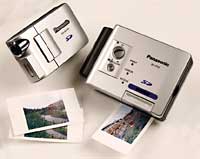 Designed (but not exclusively) for use with the SV-AV10, the SV-P10E produces small photos - one 4x3cm print or four 2x1.5cm prints on sheets of paper that are about 7x4cm. You can print from any SD card (or direct from a computer via USB). If you don't have SD cards, you can transfer data from other types of card using a laptop and a card reader. Cards slot into the front of the printer. All photos on a card are printed, unless your camera can mark individual images as not to be printed. Paper is fed into the printer one sheet at a time, and you press a button to select how many photos to print on each sheet. Like the Canon printer, below, paper and ink are supplied together. A pack with enough of both for 30 prints costs £13 - about 43p for each tiny print. The SV-P10E uses thermal printing, and photos, while reasonable, are far from outstanding. They look flat and slightly blue and, despite their small size, are slow to appear. Each 4x3cm print takes 70 seconds, compared with 45 seconds for the same size from an HP 7150. Highly portable (it runs off the mains or a battery), the SV-P10E has a footprint not much bigger than a floppy disk (it's 10x7x3cm). But you have to question whether the prints are any real use. They may go down well at parties but so do instant (and bigger) prints from a £25 Polaroid (although these cost about £1 a photo).
Picture quality/speed
Features Ease of use Portability Value ££ Overall 62%
top
CP100Canon £222  Canon's CP-100 prints postcard- or credit-card sized images straight from Canon digital cameras. The prints aren't as high quality as those from the full-sized HP 7150 - they are good, but they look slightly less natural. However, the CP-100 is much quicker (a postcard-sized print takes 80 seconds instead of 150 seconds with the 7150). Battery- or mains-powered, the CP-100 uses a technology called dye-sublimation (where ink is heated to a vapour that then diffuses on to special paper). This process makes running costs easy to predict because ink comes on a ribbon with exactly the right amount of paper. A pack of ink and paper for 36 postcard-sized images costs £12 - that's 33p per print. This is about the same as for the HP7150 - but it's less than getting digital photos developed at a commercial processor. SnappySnaps, for instance, charges 65p a print, while Fotango (an online service) charges 49p (plus £1 postage and package) - so the CP-100 is a reasonably priced way to print digital photos. You control printing from the menu of the camera (which you connect with the supplied cable) but options are limited. You can choose a border and whether to include the date, or select just a portion of an image to print. There's no real preview mode, though, or an opportunity to print a draft - so at 33p a go, mistakes are quite expensive. Although portable, the CP-100 is not one to squeeze into a two-man tent. When loaded with ink, the paper cassette and paper, its footprint is roughly that of an A4 sheet of paper, so it's almost as big as a small inkjet (it's more compact when packed up, though). It's also not that light - just over 1kg. It's a shame this works only with Canon cameras, but if you have one, it's a great way to get instant prints.
Picture quality/speed Features Ease of use Portability Value £££ Overall 72%
| |||||||||||||||||||||||||||||||||||||||||||||||||||||||||||||||||||||||||||||||||||||||||||||||||||||||||||||||||||||||||||||||||||||||||||||||||||||||||||||||||||||
Digital CamerasPocket Digital | Pentax
Pocket Digital  If you miss photo opportunities because you can't be bothered to carry your camera, Logitech's Pocket Digital may appeal. The size of a credit card, it weighs just 51g and fits in a pocket or wallet - the lens and viewfinder are well protected when the camera is off. Pictures are good enough for fun snaps on sunny days, and well exposed in bright sunlight. But there's no flash and although Logitech says its Autobrite technology helps, we found results disappointing indoors. There's no screen to see whether a snap's any good. The 16Mb memory, which can't be expanded, holds 52 top-resolution shots (1,280x960 pixels). This is OK for making 8x6-inch prints, but smaller 4x3-inch prints look better quality. Features include a self-timer and an indicator showing how much memory is left. Once home, you use a USB port to move the photos to your computer. Five high quality pictures take 20 seconds to download. The USB connection also charges the camera's built-in battery. You can edit photos with a special edition of MGI's Photosuite (although we found it a bit tedious to use).
Camera
Ease of use Value ££ Overall 48%
top
PentaxDigibinoDB 100 £270  Pentax's Digibino is a combined digital camera and binoculars - a clever idea for getting proof of the rare bird or soap star that you've spotted. The two functions integrate well. If you spy something worth capturing through the binoculars, you hit the shutter button on top. The photo sequence button can even take five pictures a second to capture a Red Arrows fly-by. The Digibino is no heavier than average compact binoculars or a digital camera. You move the eyepieces apart to suit your eyes, and focus with a responsive central wheel. You can magnify up to seven times (typical for sub-£100 binoculars). When you take the photo, you need a firm hand to stop the Digibino tilting up as a shot is taken - but despite the powerful zoom, there was no wobble in our results. Images can be reviewed on the 1.6-inch flip-up screen (which you can use as a viewfinder - although we preferred to use the binoculars). The bright, crisp images make good 6x5-inch prints. They're slightly blue, and a bit dull on cloudy days, but the ACDSee image-editing software fixes this. The 16Mb memory holds 100 best-quality images (1,024x768 pixels). You download them to a computer via USB - five top-quality pictures take 1.5 seconds.
Binoculars Features Portability Value £££ Overall 61%
| |||||||||||||||||||||||||||||||||||||||||||||||||||||||||||||||||||||||||||||||||||||||||||||||||||||||||||||||||||||||||||||||||||||||||||||||||||||||||||||||||||||
Multi-function and SpeakersSV-AV10 | TravelSound speakers
SV-AV10 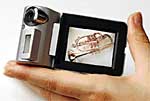 Pint-sized (cigarette-box-sized, to be exact) gadgetry at its sleekest, the 120g SV-AV10 combines a camera, camcorder and music player - but it looks better than it works. The camera takes poor images, indoors or out, at a maximum resolution of 640x480 pixels (45 photos fit on the supplied 8Mb SD card). You get reasonable 4x3-inch prints, but photos are really better suited to e-mail or the web. Even then, they lack detail. You can review photos on the two-inch LCD screen (as a slide show if you want). This doubles as a viewfinder for the camera and the camcorder, and can be rotated. Moving images are as poor as stills, and also jerky. One minute of maximum quality video (saved in MPEG4 format) takes up 4Mb - you'll need to buy a £100 128Mb SD card to save half an hour's footage. What's more, the supplied CD-MovieStage software doesn't have a lot of editing features - so you'll also need to invest in better software to produce decent quality edited footage. A built-in microphone picks up sound, so the SV-AV10 also works as a voice recorder. But recordings are no better than telephone quality and voices sound quite hissy. You listen to music in AAC or MP3 format (not WMA) through the supplied in-ear headphones - there's no speaker. The SV-AV10 comes with RealJukebox software to arrange tracks into playlists on your computer. You then transfer them to the SD card using the supplied USB card writer. An hour's worth of tunes in AAC format takes about seven minutes to copy. Track titles and artist names are displayed on the screen but this nice feature can't distract from the thin-sounding music. There are no bass or tone controls to improve things. Due to its size, menus are used to access most things, including changing the volume - a major fiddle. The menus are fairly intuitive, and controlled by two small buttons (which big hands may find hard to control). It's easy to switch between the functions, although you can't, say, listen to music and take pictures at the same time. Overall, it's a classic case of style over substance, although redeemed slightly by its portability and slick integration of features.
Camera Features Portability Value ££ Overall 51%
www.panasonic.co.uk
top
TravelSound speakersCreative £60 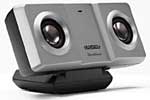 With an MP3 jukebox you can take your entire CD collection on holiday - but what if you want to share your 'all-time holiday greats' playlist with friends? The paperback-sized Creative TravelSound portable stereo speakers could be the answer. Creative promises its natty little foldable unit gives a 'bass performance that's remarkable in so compact a unit' and 'fantastic all-round audio quality uplift'. We, however, think it's tinny and lacks bass. Having said that, it's impressively loud for its size and consequently is a better bet than, say, a laptop's built-in speakers. Overall, it's pretty expensive for what it offers. If you plan to watch DVDs or play games on a laptop in a hotel room, you're better off with some decent headphones. But if you want to throw an impromptu disco at a campsite, this could win you some friends. And when the farmer comes to investigate the racket, the volume controls are easy to use.
Features Sound quaility Ease of use Portability Value ££ Overall 48%
www.europe.creative.com | |||||||||||||||||||||||||||||||||||||||||||||||||||||||||||||||||||||||||||||||||||||||||||||||||||||||||||||||||||||||||||||||||||||||||||||||||||||||||||||||||||||
Protable Storage DevicesDisgo | Pockey | Jukebox Multimedia
Disgo  The Disgo is a small, slim key fob with a difference - a detachable top that reveals a USB connector. Plug this into any computer and the 'flash memory' Disgo device acts like a hard drive. Computers with Windows ME and above automatically detect the Disgo and list it under My Computer. Files can be moved there as with a hard drive. If you have Windows 98 you must first install a driver (downloadable from www.mydisgo.com). Disgos hold 8, 16, 32, 64, 128 or 256Mb. We tested the 128Mb version but because several necessary files are preloaded, you actually get 125Mb storage, not the full 128Mb. A flashing light shows when files are transferring and they copy at 43Mb a minute, about the same as a Zip drive. Supplied KeySafe software lets you password protect files - there are no instructions but it's simple to use.
Features
Ease of use Value £££ Overall 75%  020 8902 2406 020 8902 2406www.mydisgo.com Needs: USB port. With Windows 98, you need at least a Pentium II
top
PockeyExpansys £200  This 20Gb hard drive is the size of a small pile of £5 notes and plugs into a USB port. To use it, the computer you attach it to must have the driver software installed, so it's not that portable. File transfer via USB 1.0 was 53Mb a minute - it wouldn't work with USB 2.0, even after we abandoned the badly translated instructions and rang technical support for help.
Features Ease of use Value ££ Overall 60%
top
Jukebox MultimediaArchos £320 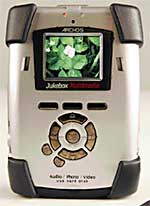 Based on the portable Jukebox Recorder hard drive (see our July issue), this Multimedia version displays video and photos on a colour 1.5-inch screen, as well as playing music and storing data files. The screen is high quality and, despite its size, you can read even small subtitles. Video clips can be jerky, though, and the sound quality of its headphones is fairly average. The 20Gb Multimedia holds the equivalent of 300 CDs in MP3, 10,000 high-quality photos, or up to 50 hours of MPEG video. Files transfer at 53Mb a minute via USB 1.1. USB 2.0 and FireWire cables will be available and should be quicker. It's sturdy, chunky and weighs 300g. Navigating menus is tricky and the carry case obscures the controls. But it has lots of features and you can buy a module to read memory cards, another to convert it to a digital camera, and one that records programmes off the television.
Picture quality Sound Features Portability Value £££ Overall 58%
| |||||||||||||||||||||||||||||||||||||||||||||||||||||||||||||||||||||||||||||||||||||||||||||||||||||||||||||||||||||||||||||||||||||||||||||||||||||||||||||||||||||
MiscellaneousWe've tested a handful of portable gadgets and accessories - but there are plenty more, some of which appear to be of more use than others. If you have a laptop, you could carry it in the Lapstation, pictured below ($70 from www.intrigo.com). It becomes a handy desk when you need to get some work done (although it looks like the trays they have for hospital food). For those who take their laptops to the desert, the FlyFan USB fan ($25, www.kensington.com) will keep you cool, and you can keep the battery charged with a portable solar charger ($100) from www.isunpower.com. 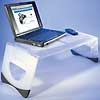 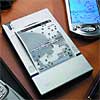 When planning a more active trip with your gadgets, TeleAdapt's patented $17 Quick Clip cases - which incorporate a super strength adhesive - are designed to keep your phone, PDA and Game Boy firmly attached to your belt or bike handlebars on the bumpiest roads. Its small four-USB-port SlimHub (£30) won't weigh you down much either, and is good for hooking several devices up to your laptop (see www.teleadapt.com). For a hard copy of the fruits of your mobile computing, Brother's new £250 battery-powered m-PRINT (pictured, above right) is designed to print from a PDA or laptop, via infrared or USB, to A7 paper. Meanwhile, two new Casio EXILIM models add to the growing pool of tiny digital cameras. Out last month, the two-megapixel EX-S2 (£300) and EX-M2 (£350) are the size of a credit card. Both record short movies and still images, and the EX-M2 plays MP3s. Sony also joined the mini-camera fray last month with the pretty 8x3x4cm DSC-U10 (£200) in silver, pink and blue. Adam Williams of Sony Digital Imaging UK claims 'you see the DSC-U10 and it stirs the emotions'. It's a 1.3 megapixel camera with a one-inch screen. Launched only in Japan so far, Sharp's Zaurus SL-A300 is one of the lightest colour PDAs (120g) and doubles as a portable USB storage device. Another storage option is the Creative MuVo, £100 - an MP3 player and USB storage device weighing just 28g. | |||||||||||||||||||||||||||||||||||||||||||||||||||||||||||||||||||||||||||||||||||||||||||||||||||||||||||||||||||||||||||||||||||||||||||||||||||||||||||||||||||||
In the Home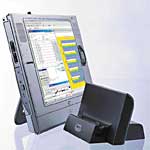 Portable computing isn't just about leaving the house. Microsoft, with manufacturers such as ViewSonic, Philips and LGE, plan to release the first Smart Displays in the US this year. The screen connects wirelessly to any computer in the house, letting you use the software and files on it in any room. Nancy Nemes from Microsoft explains: 'People want new uses for computers in the home. We want Smart Displays to free the PC from the upstairs study.' She uses a prototype. 'The great thing is that I can carry it round with no cables - downstairs to check e-mail, or sit with a friend in the living room to surf the net,' she told us. For the Smart Display to work, the main computer must be on, but you can be up to 150 feet away. It doesn't get hot (unlike a laptop), and turns on at once - there's no wait for it to start. It uses an operating system called Windows CE for Smart Display. PDAs, like the Jornada 928, p10, are powered by a version of CE and, like them, users can write straight on the 10- or 15-inch screens using Transcriber handwriting recognition software. There'll also be a choice of on-screen keyboards for tapping with fingers or a stylus. Nancy couldn't say how much a Smart Display will cost: 'But they're targeted at early adopters, and the price will reflect that.' We should see them in Europe by next spring. | |||||||||||||||||||||||||||||||||||||||||||||||||||||||||||||||||||||||||||||||||||||||||||||||||||||||||||||||||||||||||||||||||||||||||||||||||||||||||||||||||||||
Shopping ListNotesThe table shows three storage options - disc-based (including a typical CD and DVD recorder), portable hard drives, and flash memory (like the Disgo). The price is for the drive, and we give its storage capacity in Mb or Gb. For disc-based storage, we also give the price of the discs and cost per Mb is based on the disc alone. For hard drives and flash memory devices, cost per Mb is based on the price of the device. Portability is based on size and weight - the more Is a device has, the easier it is to carry.
Other capacities1 10Gb (£147), 30Gb (£254), 40Gb (£290)2 Not launched in UK yet 3 20Gb (£126), 120Gb (£250) 4 30Gb (£326), 40Gb (£375) 5 60Gb (£219), 100Gb (£317), 120Gb (£397) 6 64mb (£82), 256Mb (£264), 512Mb (£352), 128Mb (£135) 7 16Mb (£34), 32Mb (£62), 64Mb (£80), 128Mb (£136)<BR> 8 64Mb (£36), 128Mb (£65) 9 64Mb (£47), 128Mb (£76) | |||||||||||||||||||||||||||||||||||||||||||||||||||||||||||||||||||||||||||||||||||||||||||||||||||||||||||||||||||||||||||||||||||||||||||||||||||||||||||||||||||||